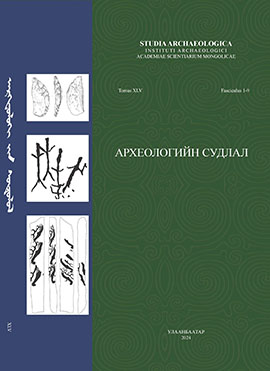Studying the morphology and semantics of Neolithic ochre rock arts
DOI:
https://doi.org/10.5564/sa.v45i2.3782Keywords:
Neolithic, Cave, Ochre painting, Human figureAbstract
The article examines the description and meaning of Neolithic ochre rock paintings, drawing from newly discovered monuments and materials near Ikh Khairkhan Mountain in the southwestern Khangai Mountains. As evidenced by these ochre paintings, post-glacial climate changes significantly influenced people’s lives and worldviews. During this period, Upper Paleolithic animal depictions evolved, with humans becoming the primary subject of ochre paintings. People were typically portrayed with outstretched arms, possibly symbolizing intentions or prayer gestures. This human representation in ochre paintings later developed into various forms in petroglyphs, with the raised-arms motif persisting until the late Stone Age and early Iron Age. Besides human figures, ochre rock paintings feature cross marks, vertical and horizontal lines, and geometric symbols. Cross marks, found in petroglyphs from the Late Paleolithic to the Late Bronze Age, are believed to span a broad timeframe. Among various interpretations of these Neolithic-associated signs, the hypothesis linking them to fire and possibly representing a group’s hearth is considered plausible. Neolithic rock paintings depict people in a rudimentary manner, similar to representations in late Selenge-type ochre paintings. However, it’s important to note that the meanings conveyed differ significantly in terms of description and semantics.
Шинэ чулуун зэвсгийн үеийн зосон зургийн дүрслэл, утга зүйн асуудалд
Хураангуй: Тус өгүүлэлд шинэ чулуун зэвсгийн үеийн хадны зосон зургийн дүрслэл, утга зүйн асуудлыг Хангайн нурууны баруун өмнөд хэсэгт орших Их хайрхан уулын орчмоос шинээр илрүүлсэн дурсгалууд хийгээд бусад хэрэглэгдэхүүнд тулгуурлан авч үзлээ. Мөстлөгийн дараах үеийн уур амьсгал, түүнээс улбаалсан хүрээлэн буй орчны хувьсал хүмүүсийн ахуй амьдрал, оюун сэтгэлгээнд ихээхэн нөлөөлжээ. Үүний нэг баримт бол хадны зосон зургийн дүрслэл, утга зүй юм. Энэ үед дээд палеолитын үеийн амьтан зурах тогтсон гэмээр дүрслэл хүнээр солигдож “хүн” зосон зургийн гол өгүүлэмж болжээ. Ингэхдээ хүнийг их төлөв хоёр гараа дэлж өргөсөн байдлаар зурдаг нь хүсэл санаагаа илэрхийлж наманчилж буйг дүрслэн үзүүлсэн гэж үзжээ. Ийнхүү зосон зурагт хүн дүрслэх болсон нь цаашид сийлмэл зурагт олон янз хэлбэр болж баяжигдсан боловч гараа өргөж наманчилж буй мэт харуулах дүрслэлийн онцлог байдал чулуун зэвсгийн төгсгөл, зэс чулууны үед хүртэл хэвээр хадгалагджээ. Зосон зурагт хүн дүрслэхээс гадна сөөлжир чагтан тэмдэг, босоо, ташуу зураас, янз бүрийн геометрийн дүрс тэмдэг зурсан байдаг. Сөөлжир чагтан тэмдэг нь палеолитын сүүл үеэс хожуу хүрлийн үе хүртэл хадны зурагт дүрслэгдсэн бөгөөд өргөн цаг хугацааны хүрээлэлд авч үздэг. Харин шинэ чулуун зэвсгийн үеийн хүнтэй хамт дүрслэгдсэн эдгээр тэмдгийн тухай олон үзэл баримтлалаас галтай холбоотой хэмээх таамгийг үнэмшилтэй хэмээн үзсэн бөгөөд бүл хүмүүсийн гал голомтыг илэрхийлж байх магадлалтай ажээ. Шинэ чулуун зэвсгийн үеийн хадны зурагт хүнийг ихэд тойм байдалтай дүрсэлдэг нь хожуу үеийн “Сэлэнгийн зосон зураг”-т хүн дүрсэлдэгтэй ихэд төстэй байна. Харин илэрхийлж буй утга агуулга, дүрслэлийн бүрдлээрээ ялгаатайг тэмдэглэжээ.
Түлхүүр үг: Неолит, агуй, хонгил, зосон зураг, хүн
Downloads
347
Downloads
Published
How to Cite
Issue
Section
License
Copyright (c) 2024 Davaakhuu Odsuren

This work is licensed under a Creative Commons Attribution-NonCommercial 4.0 International License.
Copyright on any research article in the Studia archeologica is retained by the author(s).
The authors grant the Studia archeologica license to publish the article and identify itself as the original publisher.
![]()
Articles in the Studia archeologica are Open Access articles published under a Creative Commons Attribution-NonCommercial 4.0 International License - CC BY NC.
This license permits use, distribution and reproduction in any medium, provided the original work is properly cited.




